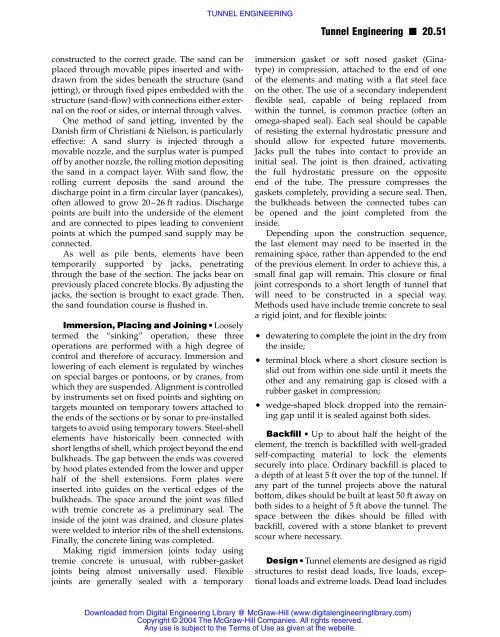TUNNEL ENGINEERING
TUNNEL ENGINEERING
TUNNEL ENGINEERING
Create successful ePaper yourself
Turn your PDF publications into a flip-book with our unique Google optimized e-Paper software.
constructed to the correct grade. The sand can be<br />
placed through movable pipes inserted and withdrawn<br />
from the sides beneath the structure (sand<br />
jetting), or through fixed pipes embedded with the<br />
structure (sand-flow) with connections either external<br />
on the roof or sides, or internal through valves.<br />
One method of sand jetting, invented by the<br />
Danish firm of Christiani & Nielson, is particularly<br />
effective: A sand slurry is injected through a<br />
movable nozzle, and the surplus water is pumped<br />
off by another nozzle, the rolling motion depositing<br />
the sand in a compact layer. With sand flow, the<br />
rolling current deposits the sand around the<br />
discharge point in a firm circular layer (pancakes),<br />
often allowed to grow 20–26 ft radius. Discharge<br />
points are built into the underside of the element<br />
and are connected to pipes leading to convenient<br />
points at which the pumped sand supply may be<br />
connected.<br />
As well as pile bents, elements have been<br />
temporarily supported by jacks, penetrating<br />
through the base of the section. The jacks bear on<br />
previously placed concrete blocks. By adjusting the<br />
jacks, the section is brought to exact grade. Then,<br />
the sand foundation course is flushed in.<br />
Immersion, Placing and Joining n Loosely<br />
termed the “sinking” operation, these three<br />
operations are performed with a high degree of<br />
control and therefore of accuracy. Immersion and<br />
lowering of each element is regulated by winches<br />
on special barges or pontoons, or by cranes, from<br />
which they are suspended. Alignment is controlled<br />
by instruments set on fixed points and sighting on<br />
targets mounted on temporary towers attached to<br />
the ends of the sections or by sonar to pre-installed<br />
targets to avoid using temporary towers. Steel-shell<br />
elements have historically been connected with<br />
short lengths of shell, which project beyond the end<br />
bulkheads. The gap between the ends was covered<br />
by hood plates extended from the lower and upper<br />
half of the shell extensions. Form plates were<br />
inserted into guides on the vertical edges of the<br />
bulkheads. The space around the joint was filled<br />
with tremie concrete as a preliminary seal. The<br />
inside of the joint was drained, and closure plates<br />
were welded to interior ribs of the shell extensions.<br />
Finally, the concrete lining was completed.<br />
Making rigid immersion joints today using<br />
tremie concrete is unusual, with rubber-gasket<br />
joints being almost universally used. Flexible<br />
joints are generally sealed with a temporary<br />
<strong>TUNNEL</strong> <strong>ENGINEERING</strong><br />
Tunnel Engineering n 20.51<br />
immersion gasket or soft nosed gasket (Ginatype)<br />
in compression, attached to the end of one<br />
of the elements and mating with a flat steel face<br />
on the other. The use of a secondary independent<br />
flexible seal, capable of being replaced from<br />
within the tunnel, is common practice (often an<br />
omega-shaped seal). Each seal should be capable<br />
of resisting the external hydrostatic pressure and<br />
should allow for expected future movements.<br />
Jacks pull the tubes into contact to provide an<br />
initial seal. The joint is then drained, activating<br />
the full hydrostatic pressure on the opposite<br />
end of the tube. The pressure compresses the<br />
gaskets completely, providing a secure seal. Then,<br />
the bulkheads between the connected tubes can<br />
be opened and the joint completed from the<br />
inside.<br />
Depending upon the construction sequence,<br />
the last element may need to be inserted in the<br />
remaining space, rather than appended to the end<br />
of the previous element. In order to achieve this, a<br />
small final gap will remain. This closure or final<br />
joint corresponds to a short length of tunnel that<br />
will need to be constructed in a special way.<br />
Methods used have include tremie concrete to seal<br />
a rigid joint, and for flexible joints:<br />
† dewatering to complete the joint in the dry from<br />
the inside;<br />
† terminal block where a short closure section is<br />
slid out from within one side until it meets the<br />
other and any remaining gap is closed with a<br />
rubber gasket in compression;<br />
† wedge-shaped block dropped into the remaining<br />
gap until it is sealed against both sides.<br />
Backfill n Up to about half the height of the<br />
element, the trench is backfilled with well-graded<br />
self-compacting material to lock the elements<br />
securely into place. Ordinary backfill is placed to<br />
a depth of at least 5 ft over the top of the tunnel. If<br />
any part of the tunnel projects above the natural<br />
bottom, dikes should be built at least 50 ft away on<br />
both sides to a height of 5 ft above the tunnel. The<br />
space between the dikes should be filled with<br />
backfill, covered with a stone blanket to prevent<br />
scour where necessary.<br />
Design n Tunnel elements are designed as rigid<br />
structures to resist dead loads, live loads, exceptional<br />
loads and extreme loads. Dead load includes<br />
Downloaded from Digital Engineering Library @ McGraw-Hill (www.digitalengineeringlibrary.com)<br />
Copyright © 2004 The McGraw-Hill Companies. All rights reserved.<br />
Any use is subject to the Terms of Use as given at the website.
















